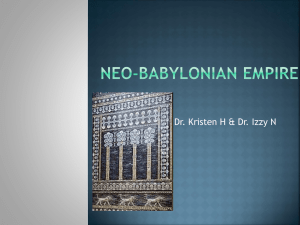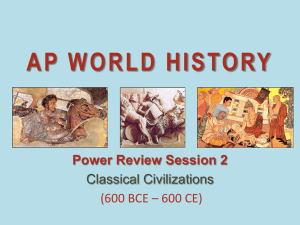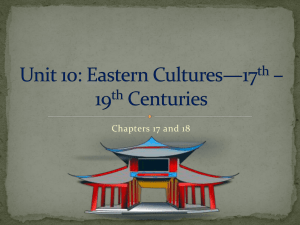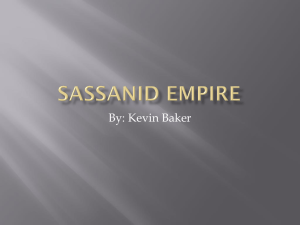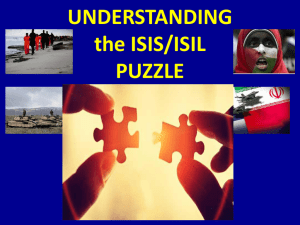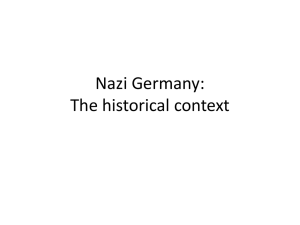Pd 6
advertisement
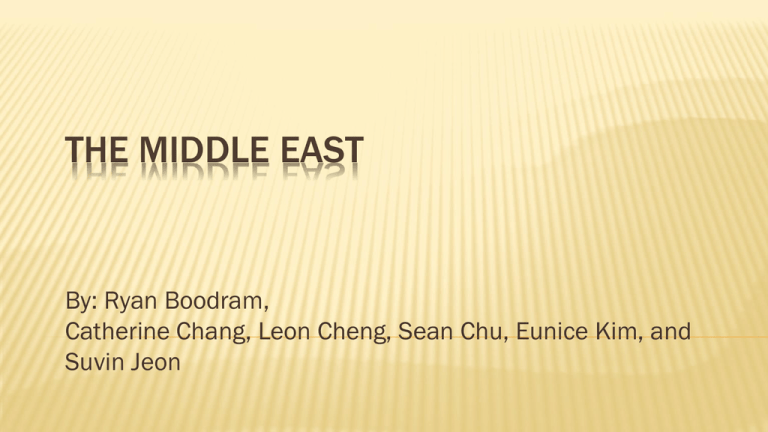
THE MIDDLE EAST By: Ryan Boodram, Catherine Chang, Leon Cheng, Sean Chu, Eunice Kim, and Suvin Jeon BEFORE 600 B.C.E Mesopotamia ❖ Located between Tigris and Euphrates river (part of Fertile Crescent) ❖ 1st notable civilization: Sumer (3000 BCE) -consisted of city-states -writing: cuneiform. Spread to other lands through trade -Polytheistic, Ziggurats created to appease gods ❖ 2nd: Babylon (1700 BCE) -Code of Hammurabi: list of laws ❖ 3rd: Hittites (1500 BCE) -Iron weapons for military ❖ 4th: Assyrians (1400 BCE) -Cruel, sent exiles away which lead to cultural diffusion BEFORE 600 B.C.E (MESOPOTAMIA CONT.) Persian Empire ❖ Built on top of a rebuilt Babylon (Chaldean king Nebuchadnezzar) ❖ From Nile River to (present-day) Afghanistan ❖ Took over Assyrians and Egyptians *Note: Judaism was founded by Abraham at this area+time Christianity a bit later, but based on Judaism BEFORE 600 B.C.E. Egypt (1400 BCE-1000 BCE) ❖ Located along the Nile River ❖ 3 kingdoms: Old, Middle, New ❖ United by King Menes ❖ Rulers were pharaohs (Centralized government) ❖ Writing: hieroglyphics- pictures ❖ Dependent on trade: liked luxury ❖ Polytheistic: mummifications and the afterlife -Pyramids built for religion, to lead body to afterlife ❖ First Female ruler: Queen Hatshepsut -greatly expanded trade ❖ Social Hierarchy: pharaoh->priests->merchants/artisans->peasants 1000 BCE 500 BCE THE RISE OF THE PERSIAN EMPIRE (600 BCE TO 600 CE) Around 550 BCE, Cyrus united the Persian tribes to create the first Persian Empire, known as the Achaemenid Persian Empire ● Society was organized similar to other empires at the time: Kings at the top, followed by warriors then priests and finally peasants ● The Achaemenid Persian Empire would eventually come to conquer Media, Lydia, Babylon, and Egypt ● The most influential ruler of the Achaemenid Persian Empire next to Cyrus was Darius I ● He divided the Empire into about twenty provinces with each province governed by a satrap (governor) ● For their religion, the Persians used Zoroastrianism but were relatively tolerant of other religions and cultures ● It can be noted that corruption and heavy taxation in the Persian Empire led to economic faltering in the conquered lands ● The Persian Empire, having failed to conquer the Greeks twice already in the Persian Wars, funded internal conflicts among the Greeks to finally capture the Greek city-states THE HELLENISTIC AGE ● ● Around 336-330 BCE, Alexander the Great of Macedonia conquered the Persian Empire ○ To maintain his large empire, Alexander built several Greek-Style cities as strategic strongholds ■ The most famous city was Alexandria which became a center of commerce and learning; Alexandria both had the first lighthouse ever built and the famous Library of Alexandria which contained works from all over the world, ■ it would later become the capital of the Ptolemy kingdom which ruled over Egypt following the collapse of the Alexander’s empire Alexander’s death led to the fracturing of his empire into three kingdoms; however by conquering such a vast swath of land, Alexander brought a unifying culture to all the different lands ○ This age is referred to as the Hellenistic Age in which Greek culture became a major influence on cultures around North Africa and West Asia Hellenistic Age, 323-30 B.C.E THE SILK ROAD ● Following the collapse of Alexander’s Empire, a group of Iranians calling themselves the Parthians took over the lands of Mesopotamia and Sumer ○ Constant border incursions with the Greeks and Romans led to this civilization becoming relatively isolated ○ While they lasted, the Parthians helped create the Silk Road ● The Silk Road was a transcontinental trade route stretching from Chang’an in Han China to Babylon in the Middle East ○ It led to the diffusion of Asian and Middle Eastern culture as well as the introduction of new technologies and animals ■ These included the stirrup which came from North Afghanistan and the Camel which was vital for the Silk Road to operate efficiently THE SASSANID AND BYZANTINE EMPIRES ● Both the Sassanid and Byzantine Empires were Empires that placed heavy emphasis on an official state religion ○ The Sassanids had Zoroastrianism and the Byzantines Christianity* ○ These two empires were among the first empires to have their societies completely revolve around religion ○ These empires were mostly intolerant of other religions ● The close proximity that these empires had to the Silk Road led to the spread of their religions throughout Eurasia ● Another religion that spread along the Silk Road was Buddhism *Christianity was founded by Jesus of Nazareth in Israel, beliefs were based on Judaism but emphasized a more personal relation with God 600 CE TO 1450 CE ● Rise of Islam ○ ○ ○ ○ ○ ○ ○ ○ ○ Around 570 C.E, Muhammad was born in Mecca Received revelations from the angel Gabriel. Founds the religion Islam based on the teachings of Muhammad. Influenced by proximity to the Byzantine and Sassanid Empires. Muhammad was exiled from Mecca in 622 and fled to Medina with his followers. Created the umma, a religious community guided by his revelations. Leads the umma in the conquest of Mecca. After Muhammad’s death, he was succeeded by Abu Bakr who created the Five Pillars of Islam and presumably ordered the creation of the holy book, Quran Muslims soon split into two main factions: the Shi’ites who believe descendants of Muhammad should be their leader, and the Sunni who believe that the Caliph should be elected RISE OF THE CALIPHATE ● ● ● Umayyad Caliphate ○ 1st major caliphate, conquered most of the Middle East ○ fell apart due to internal struggles ○ a single survivor founded a new Umayyad principality in Spain in 755 CE ○ Adopted the administrative practices of the Byzantine and Sassanid Empires Abbasid Caliphate ○ Established empire based on religion ○ Adopted culture of Sassanid Empire ○ centralized government was weak, but cultures were united by Islam ○ Berbers and Mamluks revolted leading to the breakup of the empire. Byzantine Empire Weakens ○ Underwent a period of decline similar to Fall of the Western Roman Empire ○ Technological stagnation ○ Allows the Arabs to eat away at empire. MONGOL EMPIRE ● Ilkhanate ○ ○ ○ ○ ○ ○ Mongols defeated what remained of the Abbasid Caliphate. Destroyed the irrigation systems of the Middle East Mongols employed local rulers and converted to Islam. Oversaw a period of cultural achievement as Muslims were exposed to Chinese scientific ideas. Islam also spread along the silk road. Pax Mongolia allows for the safe trading of goods between the Middle East and the Far East. EXPANSION OF ISLAM 1450 CE TO 1750 CE THE OTTOMAN EMPIRE The beginning of this time period was a time of imperial expansion for the Ottomans, and through their conquest they became one of the most powerful and well-organized states in both Europe and the Islamic world. Reasons for conquest: → wanted to expand empires for more territory as well → wanted to convert more people 1453: Ottoman Turks laid siege to Constantinople and captured it using advanced gunpowder artillery , under the leadership of Sultan Mehmed II (aka “the Conqueror”) → Constantinople now known as Istanbul → marks the end of Byzantine rule which had been around for more than 1100 years 1516-1517: Selim I (aka “the Grim”) conquers Egypt and Syria 1520-1566: Reign of Suleiman the Magnificent (aka “the Lawgiver) → peak of the Ottoman Empire → significantly expands empire in the Balkans and the eastern Mediterranean (tried to conquer Vienna but had to withdraw because winter was coming) ***Although a Sunni Islamic military state, the Ottomans practiced religious tolerance, so all peoples under their rule enjoyed peace and prosperity *** A CRISIS OF THE MILITARY STATE: WEAKENING OF THE OTTOMAN EMPIRE 1520s: the Ottoman Empire was at its peak → one of the most powerful and best-organized states in both Europe and the Islamic world but internal conflicts lead to the weakening of the empire ● military technology evolves: increased use of modern weaponry (ie- the cannon, lighter firearms) ● the number of janissaries hired to be in the army steadily increases ● the number of cavalrymen in the army is reduced in order to pay for all the janissaries, so the cavalrymen start revolting across the empire (esp. Anatolia) ● the revolts finally stop in 1610 ● the central government loses power because of these military changes and because the economy starts orienting itself towards Europe THE SAFAVID EMPIRE → similar in many aspects to the Ottoman Empire: was a military state, relied on cavalry and a land army, not a sea power) → established by Ismail Safavi, who declared it a Shi’ite state (used Shiism to legitimize rule) → Persia/present day Iran was controlled by this empire → the capital, Isfahan, was more culturally developed than Istanbul in terms of poetry, art, and architecture (i.e. mosques, palaces) → Istanbul and Isfahan were similar socially and in terms of infrastructure - cities meant for walking, lack open spaces, crowded houses, irregular and narrow streets - women do not go out at all, men dominate public life → however the two cities were different overall -Isfahan (and the Safavid empire in general) was not ethnically diverse - Istanbul is extremely diverse, with people from a variety of ethnicities residing in the city → the Safavid Empire eventually fell to Afghan invaders in 1722, because of various factors (high military costs, inflation, decline of trade) OTTOMAN-SAFAVID CONFLICT religious differences cause conflict between the two empires → Ottoman Empire: Sunni Islamic State → Safavid Empire: Shi’ite/Shia Islamic State multiple Ottoman-Safavid wars both states have military victories and defeats, but it was basically a stalemate between the two neither state decisively “defeated” the other 1639: peace treaty signed that is almost identical to present day borders of Iraq and Iran ***the military costs of this futile warfare was a major factor in the decline of both empires*** Ottoman Empire, Safavid Empire, and Mughal Empire (Gunpowder Nations) 1750 CE TO 1900 CE ● The Middle East had been shared by the Ottomans and the Persians, but during the 19th century, the French began to build the Suez canal and the British gained control of the governments of Egypt and the Ottoman Empire. ● During this time, the development of machines such as steam engines and the internal combustion engine made it far easier to extract natural resources like coal and oil. ● The Balkan Wars resulted in the loss of the Balkans from the Ottomans in 1821, and many Balkan states such as Serbia, Greece, Bulgaria, Montenegro, Romania, Croatia, Albania, and Slovenia were created. ● Egypt could not recover from the fall of the Ottomans until Mohammed Ali came into power. ● At the end of the 18th century, Sultan Selim introduced reforms to train the army European style, standardize taxes, and bring provincial governors under central government control. ● However, the Janissary, which was a group of Christian boys taken from their homes in the Balkans and converted to Islam and served for life in the Ottoman army, was becoming a powerful force in Istabnbul, Damascus, and Aleppo. ● In Serbia, the residents complained that the Janissary abused them, and Selim threatened to relocate the Janissaries to Istanbul. ● The Janissaries, thinking that Selim wanted to restrict their power, revolted and massacred Christians in Serbia. Only when Russia threatened to intervene did the struggle end with Serbia becoming effectively independent. ● Sultan Mahmud II, Selim’s cousin, took over power and announced the creation of a new artillery unit which he had secretly been training. When the Janissaries rose in revolt, he had the new unit to bombard the Janissary barracks, and the Janissary corps was officially dissolved. ● Tanzimat: a series of reforms announced by Mahmud II’s son, Abdul Mejid, in 1839 and strongly endorsed by the European ambassadors. A few examples are the proclamation that called for public trials and equal protection under the law for all, guaranteed rights of privacy, equalized the eligibility of men for enlisting in the army and provided a new method of tax collection. ● Influence of women was decreased and the political changes and economic changes narrowed women’s opportunities. They retained their right to inherit shares, and had the power to manage her own property. ● The Crimean War: A conflict between the Russian and Ottoman Empires fought in the Crimean Peninsula. To prevent Russian expansion, Britain and France sent troops to support the Ottomans. ● After the Crimean War, the Ottomans began losing power, and the Suez Canal opened up in 1869. The downfall of the empire worried a group of young men who called themselves the Young Ottomans or Young Turks, and they promoted a mix of liberal ideas derive from Europe, national pride, and modernist views of Islam. The Young Turks helped draft a constitution that was unfortunately short lived. 1750 - 1900 1900 CE - Present 1900 CE TO PRESENT ● ● ● The Last of the Ottoman Empire o By 1900, the Ottoman Empire had lost control of North Africa (ex. Egypt), and the Balkan peninsula (ex. Greece) o known as the “sick man of Europe” o inferior technology o Armenian genocide during WWI Colonization after WWI o With the secret Sykes-Picot agreement, Britain and France arranged to take countries in the Middle East as mandates, even after promising independence for their support in WWI Rise of independent nations after WWII ● Turkey o Ataturk (“father of the Turks”) led the nationalist Turks and gained independence after defeating British and Greek troops o supported modernization, as well as economic and social connections with the West o supported secularization o would be imitated by other Middle Eastern countries (ex. Pahlavi in Iran) ● Egypt o Nasser promoted economic development, westernization, and modernization o Supported secularization and suppressed the Muslim Brotherhood RELIGION ● ● ● Rise of Islamic fundamentalism o many scholars see it as a response to modern Western society (ex. scandalous attire, individualism, atheism, materialism) o Terrorism fundamentalist leaders believe that Western peoples are plagued so deeply with immoral values that it is now justified to murder terrorism isn’t limited to Western countries only: Sunni and Shi’ite groups have attacked each other Iranian Revolution o Mohammad Reza Pahlavi, shah of Iran, ruled with great inequality among the Iranian people. He supported foreign companies and used money to fund the military o Ayatollah Khomeini rose to power, supporting a return to strict religious values and ruling by sharia law o this upset the balance of power in the Middle East as Iran would inspire and support later revolutions for anti-Western governments Secularized and westernized nations o Faud regime in Egypt ISRAEL ● Zionists wanted a state for Jews ● Zionism gained support after Jews were abused in the Holocaust ● the UN and Western countries support the creation of Israel ● initial agreement offered the Palestinians their own country next to Israel ● Arab countries attacked Israel but lost and Israel took over more territory, claiming that it needed the territory for national security reasons ● Palestinians and Israelis continue to fight today ● Israel is seen by some as a move by the West to put a Christian and Western nation in a land of Arab nations 1900 CE TO PRESENT ● ● Economy o Nasser took over the Suez Canal o several Middle Eastern countries discover huge oil reserves, which led to a great source of newfound wealth o OPEC (organization of Petroleum Exporting Countries) consists mostly of Middle Eastern countries o OPEC has used the importance of oil in as leverage against the West (ex. after the Yom Kippur war) Women o Women have less power in court, less education, and less property o Women are encouraged to wear burqas or hijabs to conceal their skin o Since 1918, 45 countries in the Middle East have granted female suffrage o Women are fighting for rights for divorce and driving BIBLIOGRAPHY Bulliet, Richard W. The Earth and Its Peoples: A Global History. Boston: Houghton Mifflin, 1997. Print. Cleveland, William L. A History of the Modern Middle East. Boulder, CO: Westview, 2004. Print. Duiker, William J., and Jackson J. Spielvogel. The Essential World History. Belmont, CA: Thomson/Wadsworth, 2005. Print. Schill, Andrew. "A Brief History of Middle Eastern Oil - Abadie Schill." Abadie Schill. N.p.,n.d. Web. 6 May 2014. Laden, Jennifer, and Patrick Whelan. AP World History. New York: Kaplan Pub., 2008. Print. Monty, David, Abby, and Alexandra Freer. AP world History Exam 2012 Edition. Massachusetts: The Princeton Review,Inc, 2011. Print. "Epic World History." : Ottoman-Safavid Wars. N.p., n.d. Web. 15 May 2014. <http://epicworldhistory.blogspot.com/2012/05/ottoman-safavid-wars.html>. Pictures http://static.guim.co.uk/sys-images/Guardian/Pix/pictures/2011/4/1/1301673637817/A-woman-in-a-burqa-008.jpg http://www.gstaadschool.ch/images/uploads/general/MiddleEastMap.jpg http://www.roebuckclasses.com/maps/histmap/ad1683ottomanpower.gif http://geocrusader80.files.wordpress.com/2012/03/islamic_states_1450_lg.jpg http://www.heritage-history.com/maps/shepherd/shep008a.jpg http://hannahmcgovern.wikispaces.com/file/view/41_Safavid_Empire_2.jpg/99162591/41_Safavid_Empire_2.jpg

